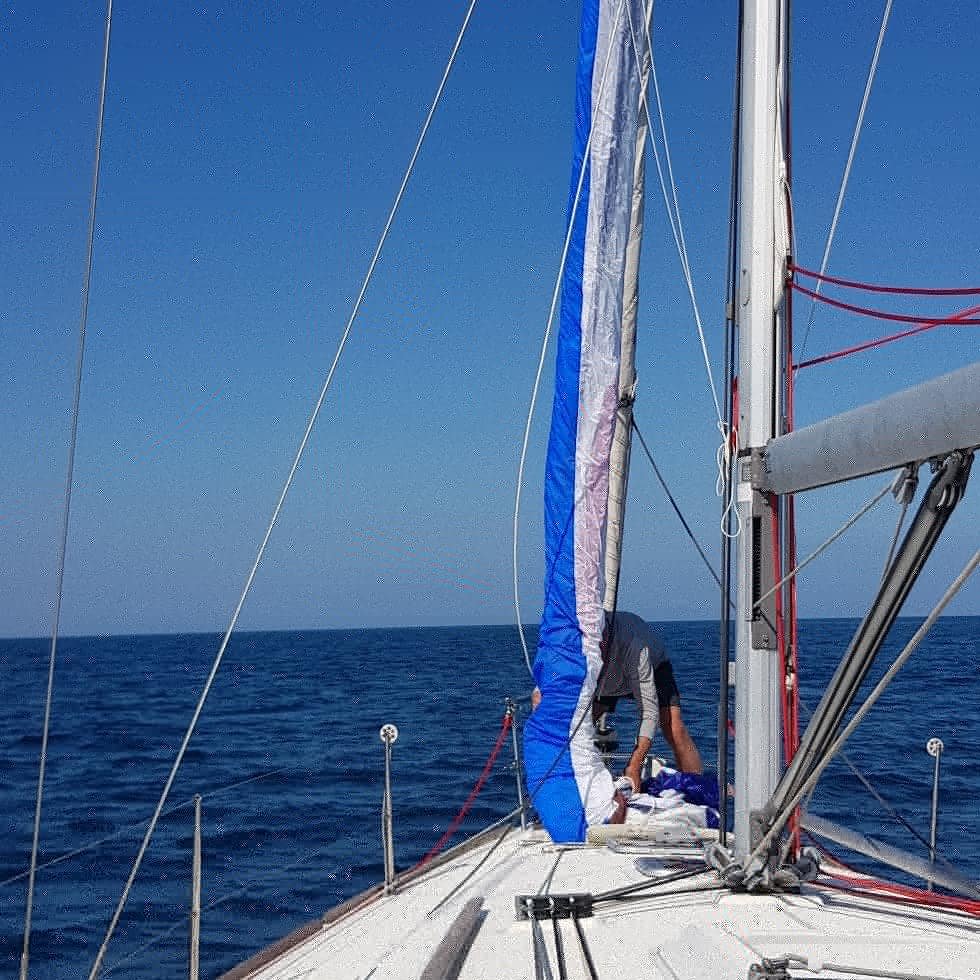
W
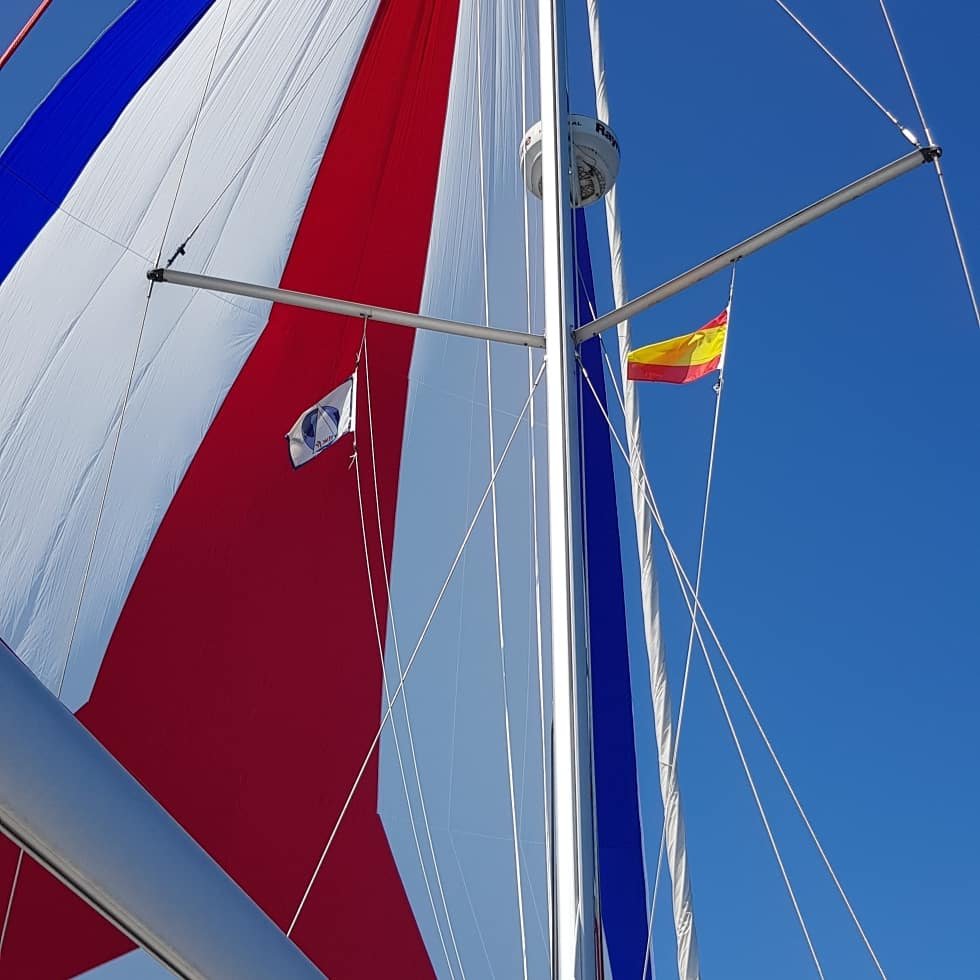

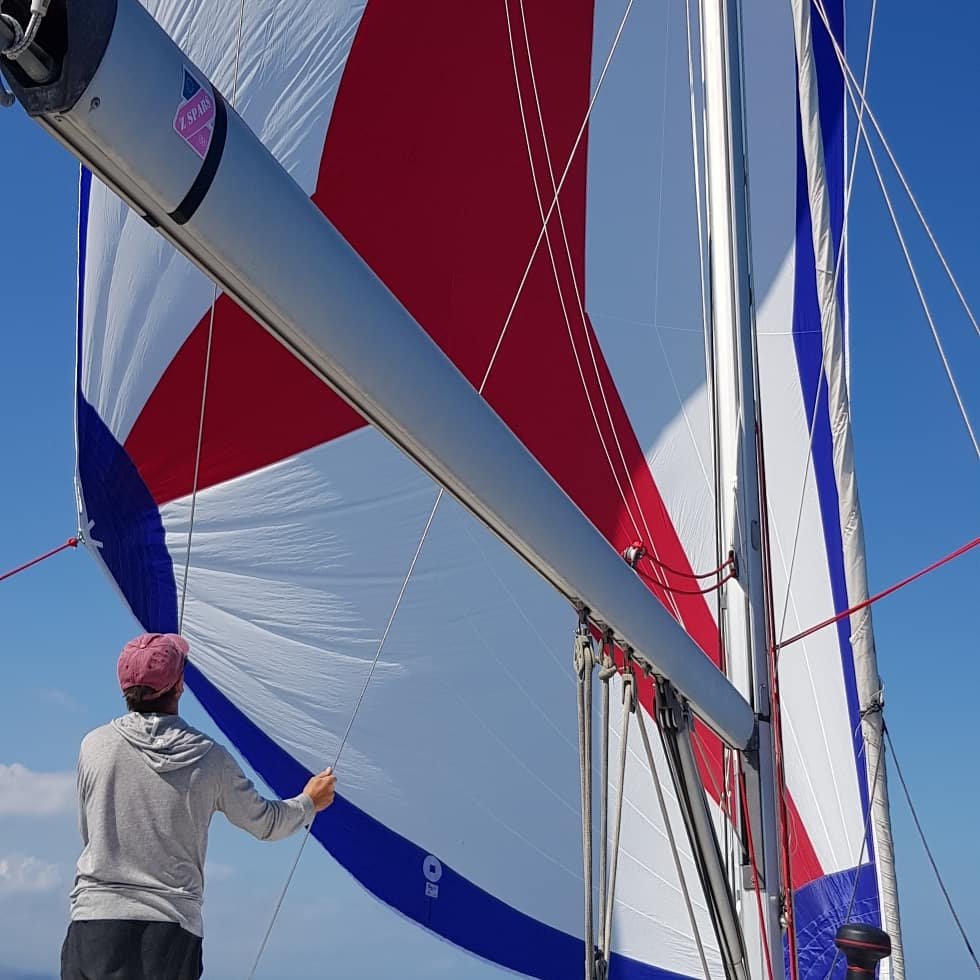
We left Santander heading for the small town of Llanes, under nice following winds and a calm see with gentle swells. We headed around the Cabo Menor and through the Cabeza de la Vaca.
Now, our avid readers (hi mom, hi Sarah!) will know that we’ve been working up to deploying our spinnaker – it’s a delicate task and about a million things can – and do – go wrong with spinnakers. After our first trials off the coast of Oléron, we decided this was the perfect opportunity to try it out. Peter got it all set out, we hoisted it up, and after a minor adjustment, she was up and flying beautifully! The lovely thing about this sail is that, with steady following winds, the boat doesn’t heel much and can carry on for hours and hours, if not days or weeks, with very little adjustment. It’s a very comfortable and efficient way to sail.
After a few hours of this lovely smooth sailing, a veritable afternoon in paradise, we needed to change tack. A very curious and innocent-looking boy named Peter went up to the front deck to initiate this easy-peasy maneuver as I watched on. He asked me to release a couple of lines, and I did so. I’ll never forget the peaceful, hopeful look on his face just before I heard some rather vulgar expletives as the spinnaker released and promptly wound itself around the Genoa, flapping furiously in the wind. Paradise lost.
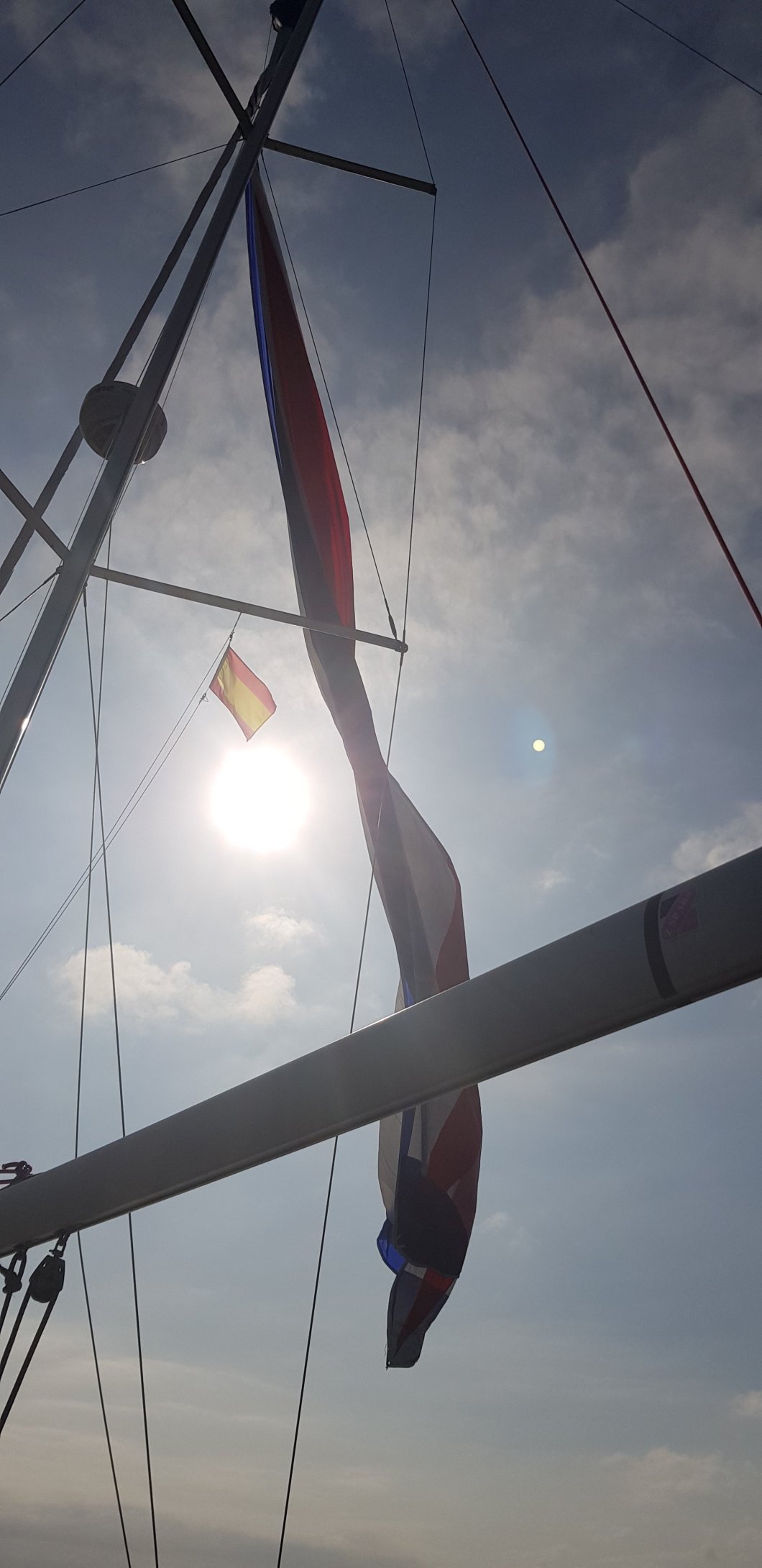
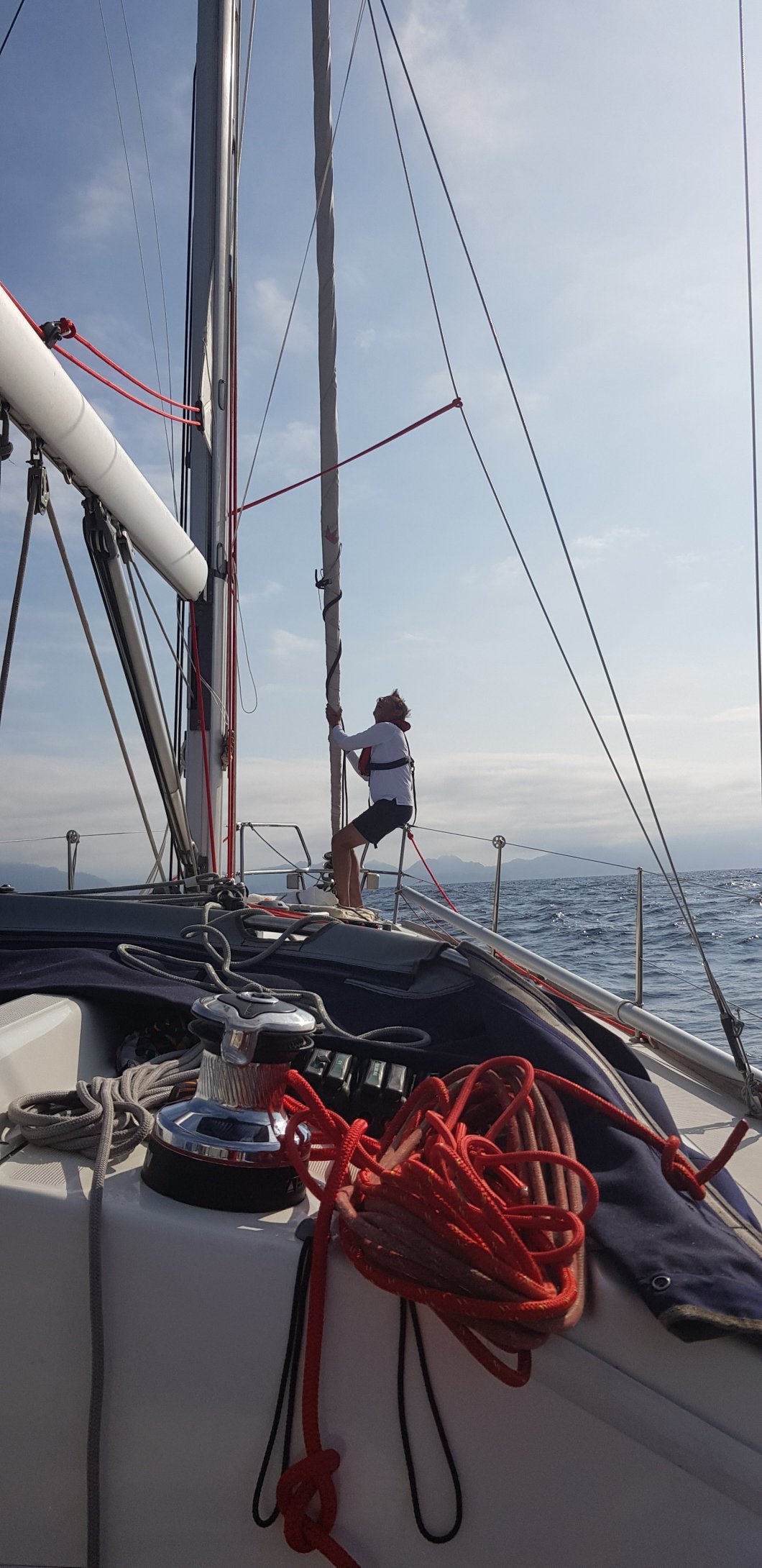
Folks, a spinnaker is a very, very powerful sail. Made of thin, nylon parachute material, it has a huge surface area, which allows it to billow out in front of the boat. This also makes it incredibly hard to “capture” once it is deployed. Even with the head of it wrapped around the Genoa mainstay, it continued to fill with air, billowing and pulling the boat with mighty force. Something akin to the term “the hounds of hell unleashed” would come into my mind repeatedly that afternoon, and that evening, and on into the night…
The gentle, sweet ocean swell that I mentioned earlier had, in the meantime, turned into the classic Biscay churner. I struggled to keep the boat facing the wind as Peter tried to do something – anything! – about the spinnaker. With shifting winds and a roiling sea, things were a little dicey.
In the end, Peter freed the spinnaker from the bottom and released it, so it was only attached at the top. It was a pretty sight to see ot flying out on the open water, but we needed to get into a safe harbor to get things under control.
Here’s something a land-lubber wouldn’t necessarily know: Aside from stranding your boat on a sandbank (or anywhere else, for that matter), there are few things more embarrassing than heading into a harbor with your sails all messed up. You just don’t want to be THAT boat, particularly because you know how much you snicker at THAT boat when you see it pass by. “Geez, learn how to sail, people! What amateurs!” you think to yourself as you share knowing smiles with your own crew.
So when the shoe is on the other foot…
With our spinnaker flying high, a sailor’s Scarlet Letter if you will, we motored down the narrow access to Ribadesella, touted as a quaint fishing village on the Sella river. It can only be accessed 2 hours either side of high tide, which in this case was 6:30PM. It was 8:15PM as we arrived, so we were under the gun, with little time to spare before the waters would be too shallow to navigate.
As people saw us come in, they began to flock. I do not use this term loosely, as flock they did. Not only was there flocking, there was also plenty of gawking. Kids, dogs, parents and grandparents gathered around to watch us. As the wind slightly dropped, I tried to wrestle the sail down, and was nearly lifted off the boat in the battle. Peter took over, and managed to tie the lower part to the mast. Minor victory. Then we tried to figure out where to tie up for the night, with rather unclear information from our Imray guide. For some reason, we did not immediately choose to go to the visitor’s pontoon, and decided to tie up to the harbor wall, an option indicated in the guide.
On the upside, there were plenty of people to throw the lines out to, so we tied up quickly. The spinnaker, now lashed partly around the mast, was still billowing and pulling up top, but at least we were moored.
Just then, as we were breathing a sigh of relief, an older gentleman approached us, speaking in Spanish. If I have learned one thing on this trip, it’s that when the old-timers are trying to tell you something, you’d best try to figure out what it is. In this case, he was trying to tell us that where we were, there would not be enough water and the keel would soon be sinking into the mud (the other most embarrassing thing you can do in a sailboat)! Peter had, of course, measured the water level, and according to our Imray guide, we would have been fine – but in our already compromised state, we didn’t need any more problems. Peter quickly found the GPS info for that spot and he pinpointed and followed the very, very narrow underwater canal leading over to the visitor’s pontoon. Shortly after, the falling tide revealed a bay full of rocks that would have loved to take a bite outta Opsimath!
But it’s not over yet, dear readers! Not yet! The wind, instead of dropping, started kicking up, whipping the top of the spinnaker into a frenzy and pushing us forcefully against the pontoon as we docked. Some fellow sailors helped us wrestle Opsi into place as she pushed and heaved broadside against the dock. It looked as though our protective fenders would pop any minute.
Once secured, we got up on deck to see what we could do. The wind just kept getting stronger and there was no way we were going to get that parachute down. So again, Peter released it from the bottom, and our flag of shame was flying once again.
This “quaint” little fishing village had other surprises in store for us! When we arrived, we noticed that there was a sort of fair with rides set up along the inner harbor. While the fellow sailors were helping us tie up, one of them mentioned something about “la musica, todo la noche.” And sure enough, about 11pm, as we fell into bed, the music seemed to be getting louder, accompanying the wind that kept forcing Opsi up against the dock. Exhausted, we managed to fall asleep somehow, and besides, surely the music was going to stop after midnight?
Peter woke up about 2am and the wind had dropped. He got the sail untangled, single-handedly. I must have slept through it, but truth be told, I knew he would handle it and get it sorted out.
About 4am I woke up, parched and feeling a little worse for wear. The music was not only going strong, it was louder still. It wasn’t just any music, but particularly bad Spanish… disco? With heavy bass and repetitive lyrics yowling “Pérro pérro pérroooooo! Pérro pérro pérroooooo! Pérro!!!!!!!” There were even sound effects thrown in, like honking cars and fog horns, laughing, shouts and vrooming cars. I looked across the harbor at the flashing lights on the spinning whirligig and the whole thing just overwhelmed my senses. I closed all the windows and the “door”, which helped not at all, and I crawled back into bed, the noise drilling into my brain. This was my idea of the ultimate torture: Put a person in a room with that music blasting and they would go absolutely nuts.
Thankfully, the sun also rises. And so it did. Peter got us out of there in the wee hours of the morning and on the high tide, in search of somewhere, anywhere, more peaceful than Ribadesella, the “quaint” little fishing village.